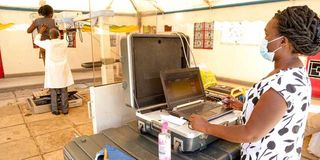At halfway point, world is decades behind its own 2030 SDG targets

A medic helps a resident onto a platform of the digital X-ray machine during tuberculosis (TB) screening at Magadi Catholic Church in Kisumu County in March 2021. TB is treatable.
What you need to know:
- In 2015, when the world replaced the MDGs, things went wrong. World leaders could again have chosen to focus on a few, crucial targets. They could even have kept the same targets since they are important.
- We could have focused on pinpointing where the needs are deepest and the opportunities greatest.
- Instead, the United Nations and world leaders came up with a hodge-podge, absurdly long list of 169 targets for the world to achieve from 2015-2030: the Sustainable Development Goals (SDGs).
In 2000, something remarkable happened: The world came together and committed to a short list of ambitious targets which became known as the Millennium Development Goals (MDGs).
The objectives—to reduce poverty, fight disease, keep children in school and so on—essentially boiled down to eight specific verifiable goals, subject to a hard deadline of 2015.
Over that one and a half decades, governments, international institutions and private foundations poured in billions of dollars more than they had before, chasing 21 targets within those goals. Global development aid alone almost doubled in real terms.
Global funding for child health increased eightfold from an annual less than a billion dollars in the 1990s to $8 billion in 2015. While we didn’t hit all the targets, this huge investment unsurprisingly turbocharged progress.
More children were kept in school and gender equality improved. Low-income countries saw death rates drop much faster than before. In 1990, nearly one child in 10 died before age five; that had more than halved by 2015. That was almost 19 million children surviving their fifth birthday who would otherwise have died.
There was a dramatic reduction in hunger: From afflicting 16 per cent of the world in 1990 to around eight per cent in 2015. That meant 300 million people avoided the lifelong effects of hunger and malnutrition. And the fight against poverty was also accelerated, cutting the number of poor by an astounding 1.2 billion people.
For the poor and vulnerable, the world simply became a much better place thanks to the MDGs. While some targets like clean drinking water and sanitation didn’t accelerate, all saw dramatic improvements, making life less hard, with less hunger, poverty and dirty water, more schooling and less death from tuberculosis, malaria and HIV, and with mothers and children dying much less.
Wrong turn
But in 2015, when the world replaced the MDGs, things went wrong. World leaders could again have chosen to focus on a few, crucial targets. They could even have kept the same targets since they are important.
We could have focused on pinpointing where the needs are deepest and the opportunities greatest. Instead, the United Nations and world leaders came up with a hodge-podge, absurdly long list of 169 targets for the world to achieve from 2015-2030: the Sustainable Development Goals (SDGs).
The SDGs promise incredibly important things like eradicating poverty and hunger, getting rid of disease and ending war and global warming. They also set targets for peripheral issues like providing green spaces. But having 169 targets is like having none; and the inevitable result is, we are falling behind on important development measures.
This year, we are at half-time of the SDGs. Yet with our current progress, even before the setbacks of Covid-19, we are likely to be half a century late on our promises. Kenya is far behind the 2030 goal line. On 2015-2019 trends, it is set to complete its SDGs around 2094! So how do we fix things from here?
First, we need to prioritise targets. For most people, less hunger and better education matter more than well-meaning pledges of increased recycling and global awareness of lifestyles in harmony with nature (two of the 169 targets). Secondly, acknowledge that some challenges can be fixed with affordable simple policies; others can’t. Promising peace and an end to violence, crime and corruption are laudable but they may be unachievable and there is little knowledge of how to do it.
In contrast, we know how to fix many pervasive problems effectively at a low cost. TB has been treatable for more than half a century yet it still quietly kills more than 1.5 million people yearly. While in nine out of 10 rich countries 10-year-olds can read and write, only one in 10 can in the poorest. And every year, more than two million children and 300,000 women die during childbirth. All these problems have cheap, effective solutions. They should get our full attention but don’t.
We will succeed when we are honest and set priorities. Let us not be the generation that failed the global promises but the one that does the smartest things best and first.
Dr Lomborg is the president of the Copenhagen Consensus and Visiting Fellow at Stanford University's Hoover Institution. [email protected]. @BjornLomborg https://lomborg.com.





